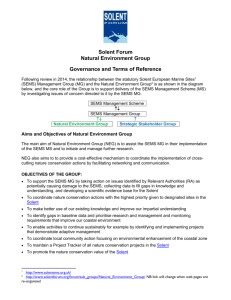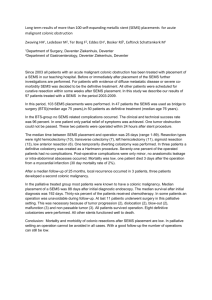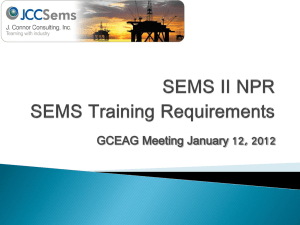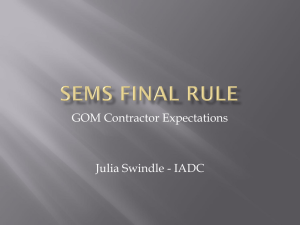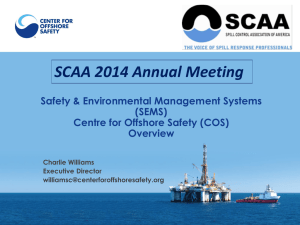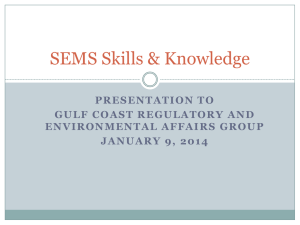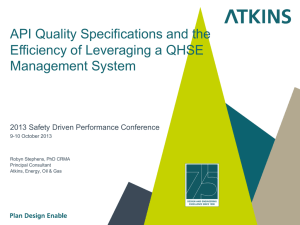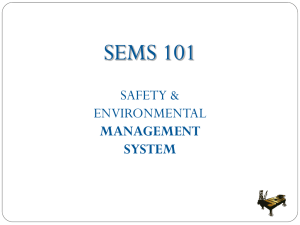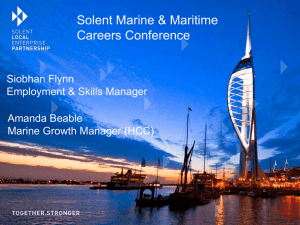SEMS Annual Monitoring Response Report, 2015
advertisement
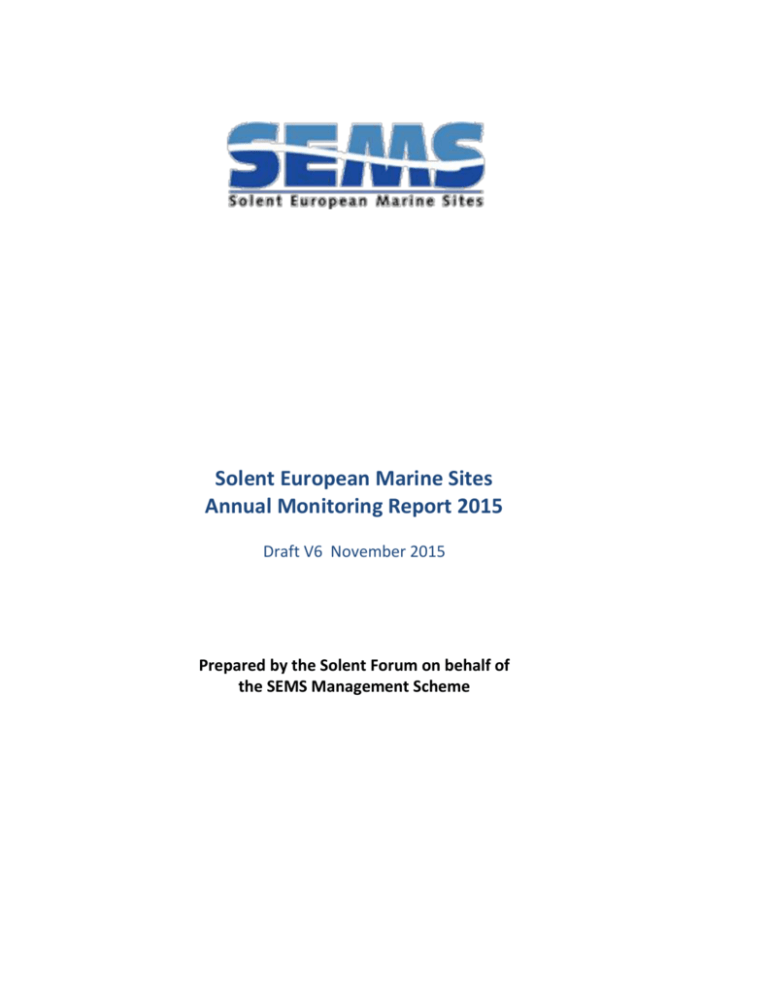
Solent European Marine Sites Annual Monitoring Report 2015 Draft V6 November 2015 Prepared by the Solent Forum on behalf of the SEMS Management Scheme Solent European Marine Sites Annual Monitoring Report 2015 Draft V6 SEMS Management Scheme 2015 Contents BACKGROUND .............................................................................................................................. 3 INTRODUCTION .............................................................................................................................. 3 SITE CONDITION ................................................................................................................................. 4 RISK CATEGORIES ............................................................................................................................... 4 ACTIVITIES AND ACTIONS FOR DELIVERY PLAN ................................................................................. 5 High Risk Activities that have increased or remained elevated ................................................................... 6 Medium Risk Activities that have increased or remained elevated............................................................. 9 Low Risk Activities that have increased or remained elevated .................................................................. 12 ACTIVITIES RESULTING FROM PLANS AND PROJECTS ...................................................................... 15 MONITORING ................................................................................................................................... 17 OTHER ISSUES ................................................................................................................................... 16 APPENDIX 1 RELEVANT AUTHORITIES AND ABBREVIATIONS............................................................................... 19 CONTACT .......................................................................................................................................... 19 2 Solent European Marine Sites Annual Monitoring Report 2015 Draft V6 SEMS Management Scheme 2015 Solent European Marine Sites Annual Monitoring Report 2015 BACKGROUND The Solent European Marine Sites (SEMS) Management Scheme was established under what is now Regulation 36 of the Habitats Regulations1. The SEMS Management Group (MG) of Relevant Authorities (RAs) runs the Management Scheme and the Solent Forum provides the secretariat. RAs are responsible for monitoring activities across the site annually, and for addressing any issues that are shown to be damaging the site. Further details on the SEMS Management Scheme can be found on the SEMS website at www.solentems.org.uk/. INTRODUCTION The SEMS Management Scheme for 2015 comprises the following three documents which can be found at www.solentems.org.uk/publications: 1 SEMS Monitoring Response Report 2015 2 SEMS Annual Monitoring Report 2015 (this report) 3 SEMS Delivery Plan 2015 The RAs each complete an online questionnaire every Spring. This survey forms the basis of the annual monitoring, and gathers details of all activities within the SEMS and of any effect that these activities are having on the condition of the SEMS. Activities are classified according to Defra’s EMS Risk Review as high, medium or low risk. 24 out of the 32 RAs who were invited to answer the questionnaire in 2015 responded. Further telephone interviews were conducted with RAs who had indicated activities that may have a detrimental effect on the SEMS, and with those who noted a possible residual impact. Full details of the on-line questionnaire results are given in the SEMS Monitoring Response Report 2015, which is available at www.solentems.org.uk/publications/. The SEMS Annual Monitoring Report (this report) summarises and assesses the SEMS monitoring responses for 2015 (from both the on-line questionnaires and any subsequent follow-up interviews and comments). It is based on the responses of the 24 relevant authorities who completed the monitoring questionnaire. It serves to inform and help the MG at their annual meeting, where they determine what actions to take forward in the SEMS 2015 Delivery Plan, and it forms a link between the other two documents. Acronyms used for the RAs are given at the end of this report. 1 The Conservation of Habitats and Species Regulations 2010 3 Solent European Marine Sites Annual Monitoring Report 2015 Draft V6 SEMS Management Scheme 2015 SITE CONDITION The condition of component SSSIs of the SEMS is assessed by Natural England every six years on a rolling programme. The most recent site condition can be found on Natural England’s Nature on the Map website. Annual monitoring of activities by the MG aims to identify threats to site condition or, at worst, early signs of any deterioration, so that timely management action can be taken to avoid damage or further evidence can be collected. In this report, therefore, site condition is only referenced where further action is needed. RISK CATEGORIES Risk is often defined as the combination of the probability of an event and its consequences. Risk can be either positive or negative. Where there is a sensitive receptor, the likelihood and severity (intensity level, duration etc) of each impact is analysed and evaluated. Thus risk is not only associated with the level of activity, but also with its likelihood and the severity of its impact. Paramotors are an example of where a low level of activity can nevertheless pose a serious risk at certain times and places. Standard risk assessment aims to identify those risks with the greatest impact and the greatest probability of occurring – these are normally addressed first, and risks with lower probability of occurrence and lower impact or threat are handled in descending order. In this report two activities have been highlighted for discussion to assess whether they should be recommended to Defra as requiring a change in their Risk Category: Fishing (commercial including shellfisheries) – from high to medium risk Littering – from low to medium risk Blue font has been used in the relevant sections to highlight where risk level is an issue. 4 Solent European Marine Sites Annual Monitoring Report 2015 Draft V6 SEMS Management Scheme 2015 ACTIVITIES AND ACTIONS FOR DELIVERY PLAN Activities taking place across the SEMS were recorded in the 2015 SEMS Monitoring Response Report which is available at http://www.solentems.org.uk/publications/. Reports of elevated or increased activity, with residual impact believed to be affecting the SEMS, were followed by one to one phone calls between the SEMS secretariat and RAs. The findings for each activity, under the risk category (high, medium or low), are summarised in this report. For each activity of concern, the following are identified: o o o o issue/s evidence management and monitoring action to be taken forward to the Delivery Plan. The activities where it was indicated that levels have increased or remained elevated during 2015 are included in this report. They are: o o o o o o Access/Land Recreation Water Sports (e.g. hovercraft, kayaking and kite surfing) Agricultural Run-off Recreational Boating Littering Navigation For Recreational Boating in one harbour and for Fishing (Commercial including Shellfisheries), although the level of activity has decreased, it is considered that fishing has not returned to a level that avoids deterioration of the SEMS. For four of the activities shown above in bold red font, there was considered to be a residual impact that may cause the condition of the SEMS to change. This red font is used in the relevant sections throughout this report. The changes for each of these activities are summarised and the need for actions to reduce the impact on the SEMS is highlighted for each activity. The actions agreed at the SEMS meeting on 30th September 2015 can be found in the SEMS 2015 Delivery Plan2. 2 The SEMS 2015 Delivery Plan can be found at http://www.solentems.org.uk/publications/ 5 Solent European Marine Sites Annual Monitoring Report 2015 Draft V6 SEMS Management Scheme 2015 High Risk Activities that have increased or remained elevated Access / Land Recreation Access / Land Recreation is considered to be a critical issue in SEMS. The Solent Recreation Mitigation Partnership (SRMP3) is now in place; however this scheme only addresses the recreational disturbance effect from new housing development. The Footprint Ecology work for the Solent Disturbance and Mitigation Project (SDMP) showed that there was already an impact from existing levels of recreational disturbance, which still needs to be addressed. The SDMP report4 includes details on which parts of the Solent EMS already exceeded the threshold number of visits for impact on the SPAs in 2012. Hundreds of new houses were built in Chichester District in 2014 and it can be assumed that these will equate to an increase in recreational usage of Chichester Harbour. Management takes place and interpretation boards around the harbour are being renewed. Chichester Harbour Conservancy (CHC) liaise with the SRMP to inform them of key disturbance areas. The Plans and Project section of this Report (pages 13-14) notes several thousand new dwellings proposed or built near the Solent, as well as various other plans or projects which are likely to affect access or land recreation. In 2014 the SEMS MG noted that many SRMP partners are planners and may not be aware of SEMS. Both of the RAs who indicated that the level of access / land recreation remains elevated (CHC and NE) believe there is a residual impact on the SEMS resulting from this; one of these (NE) believes the elevated levels of ‘Access/Land Recreation’ activities may cause the condition of the SEMS to change. Further actions already underway or being considered can be found in the Solent SIP5 which also identifies Access / Land Recreation as a critical issue. Natural England's IPENS programme has gathered information from around the English coast in a report6 entitled ‘Public access and disturbance theme plan’. Action: SEMS / NEG to keep track of SRMP actions 3 Details of the SRMP can be found at https://www.portsmouth.gov.uk/ext/community-andenvironment/environment/solent-recreation-mitigation-strategy.aspx 4 Stillman, R. A., West, A. D., Clarke, R. T. & Liley, D. (2012) Solent Disturbance and Mitigation Project Phase II: Predicting the impact of human disturbance on overwintering birds in the Solent. Report to the Solent Forum. The 2012 modelling work indicated that there were impacts from disturbance, at least for Southampton Water. http://www.solentforum.org/forum/sub_groups/Natural_Environment_Group/Disturbance_and_Mitigation_Project /SDMP_Phase2_report_Feb2012.pdf 5 The Solent SIP can be found at http://publications.naturalengland.org.uk/publication/4692013588938752 6 The IPENS reports can be found at http://publications.naturalengland.org.uk/category/5605910663659520 6 Solent European Marine Sites Annual Monitoring Report 2015 Draft V6 SEMS Management Scheme 2015 Water sports (eg hovercraft, kayaking and kite surfing) There were 3 reported increases in water sports in 2015 indicating a general and potential impact of this activity, whilst 8 authorities recorded ‘no change’. Natural England (NE) reported a general rise in water sports across SEMS due to increasing accessibility and reduced costs of equipment. Yarmouth Harbour Commissioners also had a general feeling that use of personal watercraft (particularly jet skis) has increased in their area over the last year (in summer) with many coming in for fuel, and that kayakers have been increasing in the estuary; however they were not aware of any problems. Chichester Harbour Conservancy (CHC) figures showed an increase in kayaks of 31% between 2013 and 2014. From 2015 CHC will record the number of paddleboards that use Chichester Harbour. The Conservancy is producing a leaflet to inform all water users how they can reduce their impact and disturbance of birds using the harbour. ‘No landing’ signage on the most important bird roosts will be renewed and visits to local paddleboarding and kayaking centres in Chichester Harbour will increase awareness and understanding of these measures. Navigational bulletins are also used to target watercraft users and to keep them updated. Flyboarding, which involves a "jet pack" powered by a personal water craft, was observed in Langstone Harbour for the first time during 2014. Although currently an irregular and infrequent activity, flyboarding could become a disturbing presence in the harbour if it gained popularity; Langstone Harbour Board has no regulatory mechanism for control of flyboarding. The Hovercraft Club of Great Britain remain discontent with the decision by the Department for Transport that recreational hovercraft continue to require permission from the Harbourmaster to operate within Langstone Harbour. NE believe there is a residual impact on SEMS that may cause the condition of SEMS to change; their concern is that unmanaged water sports activities in sensitive areas impact on breeding and non-breeding bird features of the SEMS. Action: NEG to carry out the further action identified in 2014 in light of student literature reviews and latest evidence, including convening a Recreation Focus Group 7 Solent European Marine Sites Annual Monitoring Report 2015 Draft V6 SEMS Management Scheme 2015 Fishing (commercial including shellfisheries) There have been recent changes to the management of commercial fisheries, which are now subject to assessment under government policy in order to comply with Article 6 of the Habitats Directive. The risk matrix approach now used to assess existing and new fisheries activity will reduce, and should eventually eliminate, damage to SEMS. The Southern Inshore Fisheries and Conservation Authority (SoIFCA) reported a decrease in fishing following the introduction of byelaws, a temporary restriction and increased enforcement in the Solent area. A further shellfish byelaw is being developed by SoIFCA. Sussex IFCA extended their oyster dredging emergency byelaw in Chichester Harbour and consulted on an Oyster Permit byelaw in early summer 2015. The public continue to report capture of undersized or illegal fish and shellfish in Langstone Harbour. Since April 2015, Prinstead in Chichester Harbour has been designated Class C for C Edule (common cockle) and Tapes spp (clam). There is a potential risk that hand collection activity for these species may increase. Despite the measures that have been taken, and the decrease in fishing activity, SoIFCA consider that fishing has not returned to a level that avoids deterioration of the SEMS. SoIFCA believe that the classification for this activity should be decreased from high to medium risk. Action: No action due to Defra approach to commercial fisheries which are now undergoing assessment 8 Solent European Marine Sites Annual Monitoring Report 2015 Draft V6 SEMS Management Scheme 2015 Bait digging Normally this report only highlights activities where an increase is reported, or where the activity level remains elevated. However in the case of bait digging in 2015, a decline or no change was recorded. Ten authorities provided responses for bait digging. Of these 8 reported no change, one unknown and one a decrease. The decrease was noted by Southampton City Council (SCC) who received anecdotal evidence from local bait diggers that the number of ragworms had dropped sharply at Weston shore and that very little bait digging was occurring. It is not clear at present whether this is part of a natural population cycle or a result of other factors. The apparent decline in ragworm levels was reported to Portsmouth University; Gordon Watson believes the ‘crash’ could be a normal population fluctuation. The decline has been noted here as ragworm populations are suffering a reduction from unknown cause/s; this could affect the condition of the SEMS. It will be important to link activities such as bait digging to the SEMS condition assessment. At present Natural England are revising the methodology for condition assessment. Action: Discuss further with Gordon Watson the extent and cause of decline in ragworms Action: SoIFCA to continue their enforcement of bye-laws on bait digging with support from RAs where appropriate 9 Solent European Marine Sites Annual Monitoring Report 2015 Draft V6 SEMS Management Scheme 2015 Medium Risk Activities that have increased or remained elevated Agricultural run-off No specific change is reported, however Natural England (NE) note that levels of Dissolved Inorganic Nitrogen (DIN) and opportunistic macroalgae remain high in the estuarine water bodies of the Solent and many are not meeting Water Framework Directive (WFD) requirements for Good Ecological Status/Potential; failure to meet these standards will also result in a failure to meet Favourable Conservation Status for the European sites. The following water bodies / estuaries are particularly affected: Portsmouth Harbour, Langstone Harbour, Chichester Harbour, Hamble Estuary, Newtown Harbour, Eastern Yar, Western Yar, Wootton Creek. The Environment Agency (EA) have completed modelling of nutrient inputs to Solent Harbours to identify the main sources of nutrients, including agricultural run-off. This has confirmed that agricultural diffuse pollution is a major source of nutrient enrichment in coastal waters of the Solent. This information can help identify where to target land management issues. The EA have helped Natural England scope their project to assess the uptake and success of certain agricultural measures in reducing diffuse nitrogen pollution in the Solent area. NE’s management is taking place through Environmental Stewardship options and capital works, Catchment Sensitive Farming grants and farm advice. More detail of management actions can be found in Natural England’s Solent Site Improvement Plan (SIP7). Due to the lag time for DIN to move through the groundwaters from source to the Solent, it is anticipated that levels will remain elevated for many years to come. Furthermore, the reductions of DIN loads required to reduce macroalgae levels below the target required for Good Ecological Status/Potential cannot be achieved via existing measures There will be two presentations on agricultural run-off research and management at the SEMS MG meeting on 30th September 2015. More information on the EA’s WFD DIN and Ecological Impact Investigations can be obtained from MarineSE@environment-agency.gov.uk. Natural England believe there is a residual impact on the SEMS from agricultural run-off that may cause the condition of the SEMS to change. Action: Discuss and review success of last year’s action to implement actions in the Solent DWPP and other actions including results of the EA’s TraC study, the South Downs Source Apportionment study and NFPNA catchment study results; agree further actions as required 7 The Solent SIP can be found at http://publications.naturalengland.org.uk/publication/4692013588938752 10 Solent European Marine Sites Annual Monitoring Report 2015 Draft V6 SEMS Management Scheme 2015 Airborne Activities There was no change in the level of activity for airborne sports, despite concerns raised in recent years. Recreational Boating Only Chichester Harbour Conservancy recorded an increase in recreational boating in 2015. Their accurate records showed an overall increase of 8% in 2014 for all types of power and sail vessels. The main increases were an 11% increase in motorboats (1064 to 1182) and a 67% increase in windsurfers (from 33 to 55). The other categories of vessel remain very similar (all less than a 5% change). Management measures in Chichester Harbour are similar to those for water sports, as described earlier in this report on page 8. The number of Annual Harbour Dues sold in Langstone Harbour during 2014 was down very slightly to 1081. Daily Harbour dues showed a greater decrease, down to 16% to 485. These figures indicate a small decrease in recreational boating activity within Langstone Harbour. The cause of this change is unknown (there is no management). Despite the reduction in numbers, Langstone Harbour Board considers that the level of recreational boating activity has not returned to a level that avoids deterioration of the SEMS. Action: Recreation Focus Group to incorporate evidence from recreational boating in their other actions being undertaken for water sports and airborne sports 11 Solent European Marine Sites Annual Monitoring Report 2015 Draft V6 SEMS Management Scheme 2015 Low Risk Activities that have increased or remained elevated Littering Whilst 8 authorities reported no change in the level of littering, and one noted a decrease, Langstone Harbour Board (LHB) reported that plastic litter has continued to enter Langstone Harbour in significant quantities as a result of unscreened sewage discharges from the Combined Sewer Overflow (CSO) at Fort Cumberland in Eastney. Large quantities of items continued to be released into Langstone Harbour whenever it rained heavily throughout the year. Southern Water, who manage Eastney CSO, employ contractors to collect this litter from the strandlines but collection has not always been timely or effective. It is certain that a proportion of this litter remains in the marine environment. LHB believe that completion of the renovation at Fort Cumberland will not solve this problem entirely, as small plastic items (including cotton bud sticks and plastic beads) are able to pass through the screening system so will continue to enter the SEMS during periods of heavy rain. Some small pieces of plastic pass through the screens and into the harbour when the water authority is operating within its discharge consent conditions. The Fort Cumberland storm outfall major improvement works were completed in January 2015. Southern Water Services have also invested in a multi-million pound surface water separation system in Portsmouth and Southsea to limit the quantity of clean water passing through to the Budds Farm Waste Water Treatment Works during rainfall periods. The spills from Fort Cumberland storm outfall are monitored and have shown that it has only spilt twice in the last 9 months. The storm outfall was operating as expected e.g. during heavy rainfall when the rate of flow exceeds the capacity of the sewer. These discharges are required to prevent properties from flooding and are permitted activities. Screens are put on the storm outfalls to prevent debris discharging to the environment. The maximum dimension of the screen apertures is 6mm in 2 dimensions. Screen apertures any smaller would be ineffective in allowing storm water to pass through. Unfortunately some smaller sized litter does pass through when they are in operation and there is not the technology currently to remove small objects from the discharge. Southern Water Services has a condition in the permit which state: ‘Where the discharge results in unsatisfactory solid matter being visible in the receiving watercourse or on the banks of the receiving watercourse, in the vicinity of the outfall, the Consent Holder shall take all reasonable steps to collect and remove such matter as soon as reasonably practicable after the discharge has been reported’. The EA do check this has been undertaken, but it should be noted that it is not practical or feasible to remove all small objects that are discharged, or differentiate between the different sources that the materials may have derived from. Combined Sewer Overflows (CSO’s) are permitted to discharge when the pass forward rate exceeds the capacity of the sewer. These outfalls also have telemetry equipment and the spill data is monitored. Southern Water Services are required to undertake sewer network modelling through the AMP investigation programme which will identify where improvement measures are required to prevent outfalls spilling excessively. This investigation work should be complete by March 2017. The EA will also use this information to consider if the permit conditions need 12 Solent European Marine Sites Annual Monitoring Report 2015 Draft V6 SEMS Management Scheme 2015 modifying. The Water Company will need to get OFWAT approval before investing in infrastructure improvement schemes – this may not happen until AMP7 – 2020 onwards. LHB are concerned because the persistent nature of plastic means it will remain in the marine environment for hundreds of years. Plastic can cause entanglement and ingestion problems for wildlife. Over time these plastics are likely to be broken down by the mechanical action of the sea into microplastics which are small enough to enter the food chain. Litter can cause wildlife entanglement and ingestion problems, can smother saltmarsh vegetation, and can break down into micro particles and enter the marine food chain. Removal of litter from the marine environment is very costly at best and impossible at worst. The EA are not in a position to do much more from a regulatory point of view with regards to some of the contaminants mentioned which come from various different sources and locations. We all need to continue to educate people or do engagement campaigns to persuade public not to put plastic and sanitary products down the toilet. Similarly with the wider plastic issue which is a global problem, persuading public to reuse or recycle plastics etc may help. Maybe SEMs could do more public campaigning activity? Further negative implications of the release of untreated sewage into Langstone Harbour have been observed in the past year. In October 2014 the native oyster beds Ostrea edulis were reclassified at Class C (formerly Class B) as a result of the presence of extremely high levels of the faecal coliform E. coli in the shellfish flesh. Additionally, during February 2015 all shellfish beds throughout Langstone and Portsmouth Harbours were closed to commercial fishing following an outbreak of Hepatitis A in the city which coincided with extended periods of storm water discharges. LHB consider that high levels of bacteria, viruses, nutrients, pharmaceuticals and other chemical compounds being discharged into the sea each time it rains have a negative impact on the SEMS. Faecal contamination can arise from numerous sources such as recreational boating, dog and bird faeces, run off from fields with livestock, sewage treatment works, etc. The EA have explained the situation with the Storm outfalls and CSO’s. We will continue to work with: our Catchment Sensitive Farming partners to ensure compliance is achieved and advice is provided to land managers; the Local Authority provide facilities and enforce dog fouling, and address misconnection issues; and best practice is promoted through initiatives such as the Green Blue/Love Where you Sail. The EA will continue to protect and improve the environment through our regulatory duty. The Council and IFCA are best placed to comment on the closure of the commercial shellfish beds. In December 2014 Southern Water completed extensive improvements to CSO discharges from Eastney Wastewater Pumping Station and Fort Cumberland Storm Tanks to Langstone Harbour. The works are now completed, significantly reducing the sewage litter discharged in storm water 13 Solent European Marine Sites Annual Monitoring Report 2015 Draft V6 SEMS Management Scheme 2015 flows to Langstone Harbour. Southern Water continues its campaign to reduce the amount of unwanted materials entering the sewer in the first place. Further information is needed to inform further action, including the extent of plastic littering elsewhere in SEMS, if possible an indication of the origin of materials and details of the legislation governing CSO consents. In light of this information a discussion is needed regarding what action/s can or cannot be taken by the SEMS MG with regard to plastic littering. NEG will discuss microplastics at their meeting on 21st October 2015. LHB believe there is a residual impact on the SEMS and that this may cause the condition of the SEMS to change. LHB believe this year, as well as last year, that the classification for this activity should be increased from low to medium risk. Action: RAs to provide further evidence of plastic littering, if possible identifying whether source is local, upstream or offshore Action: Seek advice from EA regarding consent limits and discharges of plastics from CSOs this advice has been incorporated into the text above Action: Discuss what SEMS can and cannot do regarding plastic and other littering, particularly in Langstone Harbour, and whether further investigation by NEG is required. It would be advantageous for NEG to review or gather evidence to understand the impact of littering and options/opportunities to address this. Action: NEG to seek further evidence through SEMS protocol and consider recommendation of change of risk category to Defra Navigation (maintenance of infrastructure) The first phase of construction of the Cowes outer harbour breakwater led to changes in navigational infrastructure throughout the year and ongoing into 2015. Additional markers, beacons and monitoring were put in place, as well as widespread publicity and stakeholder engagement. This will continue in the second phase of the construction in 2015. The new breakwater will change navigation in the harbour. Action: No further action identified 14 Solent European Marine Sites Annual Monitoring Report 2015 Draft V6 SEMS Management Scheme 2015 ACTIVITIES RESULTING FROM PLANS AND PROJECTS This section of the SEMS Annual Monitoring Report 2015 is provided for information. Plans and projects are assessed under Part 6 of the Habitats Regulations 2010 and are not considered under the SEMS Management Scheme. The Solent Recreation and Mitigation Strategy is being progressed and RAs are implementing appropriate avoidance strategies to reduce the impacts of plans, including residential developments. Many of these are listed in the SEMS Monitoring Response Report 2015, together with other mitigation measures. Members of the SEMS Management Group have been consulted on, or noted, the following plans or projects, many of which are extensive and may result in additional recreational and other demands in the SEMS: West Wight Coastal Flood and Erosion Risk Management Strategy, 2014-2016 Medina Greenway: The Newport to Island Harbour shared use route was completed this year A number of proposals in Langstone Harbour pending decision, which involve habitat loss or affect waterfowl feeding areas, for which mitigation is being sought A planning application known as "land to the west of Chichester" proposes to build 1600 homes within walking distance of the Fishbourne Channel in Chichester Harbour West Sussex County Council note that new housing and other development in the Chichester Local Plan area may result in increased recreational disturbance to SEMS, such as Chichester Harbour An allocation of approximately 3,500 dwellings at North Whiteley in the adopted Winchester Local Plan Part 1 (Joint Core Strategy); a planning application for the development has recently been submitted to the Local Authority (March 2015) Winchester Local Plan Part 2 (site allocations) will allocate new housing sites within an area which is likely to have a likely significant effect on the SEMS due to increased recreational activity Development of Test Valley Borough Revised Local Plan continues. A Habitat Regulation Assessment has identified the potential for in combination recreational pressures on the Solent SPAs and proposes contributions towards the Solent Recreation Mitigation Partnership schemes as a way forward. Other planning applications coming forward separately from this plan are subject to the same approach to mitigation Southampton City Council has granted consent for several hundred residential units Eastleigh Borough Council has permitted various housing applications which are being mitigated via the measures within the Solent Disturbance Mitigation Strategy Future proposals to improve the A27 around Chichester & associated junctions/local road network could impact on Chichester Harbour, possibly through increased access. Natural England has been consulted on two tidal energy trials within the SEMS - if consented these would represent a new activity within the site. Other consultations for plans / projects have been at a similar level / type of development to previous years. Trinity Lighthouse Service and Hampshire County Council have been consulted over the Navitus Bay Offshore Wind Farm proposals. 15 Solent European Marine Sites Annual Monitoring Report 2015 Draft V6 SEMS Management Scheme 2015 Yarmouth Harbour Commissioners report tidal turbine testing within their jurisdiction. If successful, this may lead to permanent placement of tidal turbine which would be a new project in this area. The capital dredge of the Portsmouth Approach channel should commence later in 2015 The major dredge of Southampton Water and its Approaches has been completed; the Environment Agency (EA) worked with ABP to ensure that risks to migratory fish and shellfish were well managed during the dredge. The EA have undertaken misconnection campaigns in partnership with Local Authorities and Southern Water and thereby reduced urban pollution entering the Solent and its harbours Lymington Harbour Commissioners are undertaking a licensed 3 year Habitat Replenishment trial which involves disposal of dredged sediment on the Solent edge of the intertidal mudflat abutting the salt marsh just east of the river entrance. The trial aims to raise the intertidal mud level to provide more protection to the salt marsh behind from wind wave action CHC has been consulted on several planning applications for new sea defences on currently undefended areas of Chichester Harbour shoreline. One purpose of these defences is the protection of footpaths. There is concern that defences that are consented will contribute to coastal squeeze of the SEMS. CHC is renewing its sea defence planning guidelines 16 Solent European Marine Sites Annual Monitoring Report 2015 Draft V6 SEMS Management Scheme 2015 MONITORING The SEMS Annual Monitoring Response Report 2015 contains a useful section on all the monitoring being done, and planned, by relevant authorities in the SEMS. Eight RAs have templates for recording the results of monitoring and eleven RAs are co-ordinating with other organisations. A separate summary of monitoring being undertaken in the SEMS in 2015 has been prepared and may assist future co-ordination and collaboration; it is available on the SEMS website at http://www.solentems.org.uk/publications/. The Solent Recreation and Mitigation Partnership (SRMP) is commissioning Footprint Ecology to develop an effectiveness methodology for the SRMP measures. Effectiveness monitoring will commence in 2017/18 and will be carried out every three years. 17 Solent European Marine Sites Annual Monitoring Report 2015 Draft V6 SEMS Management Scheme 2015 OTHER ISSUES Chichester District Council have had several noise complaints about use of gas gun bird-scarers by farmers. With the use of winter crops these are now being used outside of the spring/summer crop season. The use of fields near the SPA by over-wintering birds is well understood but there seems to be little control over these devices, or information on the potential risk. Chichester Harbour Conservancy are concerned as to why Shelduck numbers are continuing to decline in Chichester Harbour. Shelduck numbers in Chichester Harbour and Langstone SPA are now more than 70% lower than they were when the site was designated as an SPA. The 2013/2014 peak count of 309 in January 2014 was the lowest count ever recorded for Shelduck in Chichester Harbour, from records that go back until 1965. The nationally important threshold for Shelduck is 610 individuals and Chichester Harbour therefore fell below this in 2013/14. During the year 2014/15, Southern Water has completed improvements at a number of wastewater treatment works that discharge treated sewage effluent into the Solent area. These form part of the National Environment Programme (NEP) within the AMP5 programme (Asset Management Plan) to meet new, more stringent, environmental standards set by the Environment Agency. The sites include treatment works at Bosham and Thornham (Chichester Harbour), Peel Common (Solent), Bursledon (River Hamble), Millbrook and Slowhill Copse Marchwood (Southampton Water), Pennington (Solent), Newtown Isle of Wight (Newton River) and Brading (River Yar). Bursledon and Brading Wastewater Treatment Works (noted above) both ceased to operate in June 2014. The Works have been replaced by new pumping stations that transfer flows to Peel Common and Sandown Wastewater Treatment Works respectively, from which the treated effluent is discharged via long sea outfalls. Continuous flows of wastewater into the River Hamble and River Yar have therefore ceased, although the intermittent discharge of treated storm water may occur during rainfall events as allowed by permit from the Environment Agency. A major reconstruction of Woolston Wastewater Treatment Works has also commenced and will be completed in 2019. 18 Solent European Marine Sites Annual Monitoring Report 2015 Draft V6 SEMS Management Scheme 2015 APPENDIX 1 RELEVANT AUTHORITIES AND ABBREVIATIONS Authority Associated British Ports Beaulieu River Management Chichester District Council Chichester Harbour Conservancy Cowes Harbour Commissioners Eastleigh Borough Council Environment Agency Fareham Borough Council Gosport Borough Council Hampshire County Council Havant Borough Council Isle of Wight Council Langstone Harbour Board Lymington Harbour Commissioners Marine Management Organisation Natural England New Forest District Council New Forest National Park Authority Portsmouth City Council Portsmouth International Port QHM Portsmouth River Hamble Harbour Authority (Hampshire County Council) Southampton City Council Southern Inshore Fisheries and Conservation Authority Southern Water Sussex Inshore Fisheries and Conservation Authority Test Valley Borough Council Trinity House Lighthouse Service West Sussex County Council Wightlink Winchester City Council Yarmouth Harbour Commissioners Code ABP BRM CDC CHC CoHC EBC EA FBC GBC HCC HBC IoWC LHB LHC MMO NE NFDC NFNPA PCC PIP QHMP RHHA SCC SoIFCA SWS SxIFCA TVBC THLS WSCC WL WCC YHC CONTACT Solent European Marine Site Secretariat, The Solent Forum, Hampshire County Council, Elizabeth II Court West The Castle, Winchester, SO23 8UD Telephone 01962 845011 / 846027 Email sems@hants.gov.uk 19
